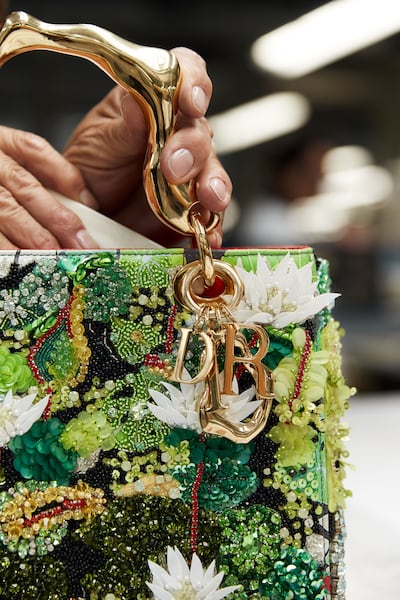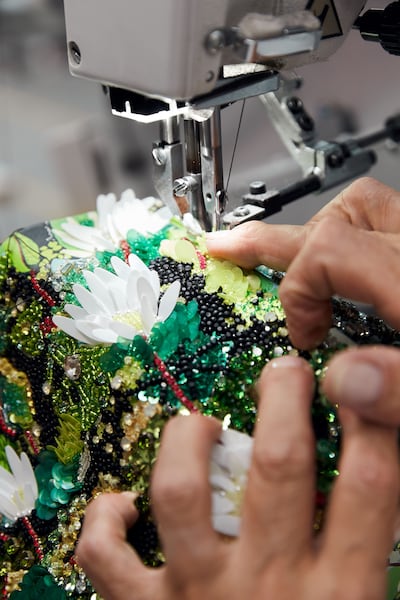The French fashion house of Dior has long been synonymous with art. The journey began before the brand itself, as founder Christian Dior ran a gallery before he turned to fashion design.
More recently, the house has collaborated with the likes of street artist Kaws on limited-edition collectables and dressed its haute couture runways with works by Portuguese artist Joana Vasconcelos, Indian duo Manu and Madhvi Parekh and the surrealist vision of Argentine-Italian painter Leonor Fini.
To help cement this artistic bond, in 2016, the luxury house launched a one-off collaboration, where a coterie of artists were invited to decorate the famous Lady Dior bag and reimagine it as per their vision.
The collection, which included interpretations from artists such as Mat Collishaw, Ian Davenport, Daniel Gordon and Chris Martin, was unveiled at Art Basel in Miami, with results that included a bag by British artist Marc Quinn covered in eyes with dilated pupils; and a version fashioned in glass by Swiss-born artist Olympia Scarry.

Fast-forward to today, and what was meant to be a one-off collaboration, has developed into an annual project, now in its eighth season. Each year, the house tasks a new stable of artists, which has so far included the likes of feminist artist Judy Chicago, Egyptian artist Ghada Amer and Saudi Arabia's Manal AlDowayan.
For this latest iteration, Dior invited artists Mircea Cantor, Jeffrey Gibson, Gilbert & George, Zadie Xa, Ha Chong-hyun, Lee Kun-yong, Mariko Mori, Ludovic Nkoth, Mickalene Thomas, Michaela Yearwood-Dan and Xu Zhen to rework the classic, hard-sided bag.
Another contributor to the project is American artist Hilary Pecis, whose rich and vivid paintings capture tropical Californian life via crowded tableaus of objects and flowers. With a loose, energetic painting style, she applies her paint in urgent strokes. Combined with the skill of the Dior atelier, this same language has now been transposed onto the Lady Dior bag, with Pecis’s fluid foliage captured in intricate beadwork.
Echoing imagery of her work Water Lilies last year, the same broad leaves, colourful stems and flower petals are now rendered in shifting tones of green beading, from pale chlorophyll to deep forest green, with touches of yellow and pinky-red for the stem of the flowers. White is used for petals that stretch upwards. Between the leaves, dark green spaces suggest deep water.
The intricate details of her work are replicated in beading, a painstakingly slow and precise technique that takes hours to perfect. Meanwhile, the top handle’s arc is now in metal-like gilded driftwood, while only the logo letter charms are unchanged.

The bag is finished with a jolt of scarlet lining. The result, Pecis explains, is in part an homage to her grandmother. “I wanted the bag to be decorative, appealing to my inner child who loved all of my grandmother’s wonderfully sequinned and beaded purses. The materials are a blend of beads, stones, sequins and threads, interpreting the painting of lily pads and water lilies.”
Pecis’s choice of flowers is typical of her work, making it fitting for the mood of Dior. Lily of the Valley was Dior’s favourite flower, which he often included in his couture designs, while for his 2012 debut, Raf Simons revealed his first haute couture collection against a wall of blooms.
Maria Grazia Chiuri, who has led the womenswear collections at the house since 2016, regularly features florals in her designs, from embroidered and beaded flowers to petals and trailing greenery, while for her spring/summer 2020 show, it was a garden that inspired the entire offering.
Digging deeper, on returning to Paris after the horrors of the Second World War, Christian Dior’s sister Catherine chose a life trading flowers at Les Halles Market, bringing Provencal blooms to Paris.
Since it was first designed in 1994, the Lady Dior bag has become a staple of the house, beloved for its timeless shape, featuring a top handle and a quilted, cannage finish, inspired by the Napoleon III chairs owned by Dior.
With a history as colourful as the artworks that now cover it, the bag was initially named the Chouchou, until Bernadette Chirac, the former first lady of France, gifted one to Diana, Princess of Wales, during a visit to Paris in 1995.
Chirac had the bag especially re-made for Diana, asking Dior to switch the then-standard fabric exterior for leather, inadvertently sparking a new design in the process. The princess was seemingly delighted with her new addition and was photographed repeatedly with it, even buying additional bags when she returned to London. Having the seal of approval from the woman who was, arguably the most famous in the world at the time, triggered a demand so great, the bag sold out worldwide. Dior renamed the bag in her honour, making it the Lady Dior after her birth title.
While the name has evolved, the structure of the piece has remained unchanged in the 25-plus years since, with its distinctive, elegant rectangular shape, the same top handles and hanging metal charms that spell out the name Dior. While it is now available in myriad materials, the quilted cannage stitching is a signature. It remains a bestseller, bolstered by these ongoing art collaborations, which offer artists a platform to embrace a new medium and reach out to a new audience. For customers, these limited-edition collector’s items offer a moment to enjoy pieces of wearable art.




